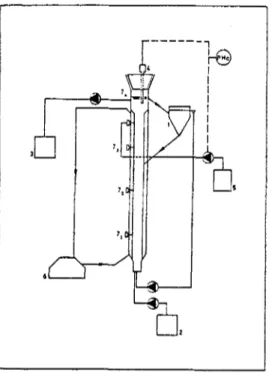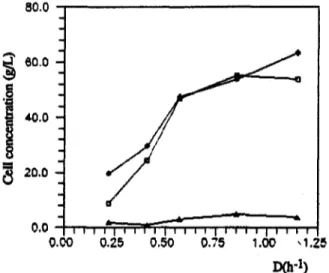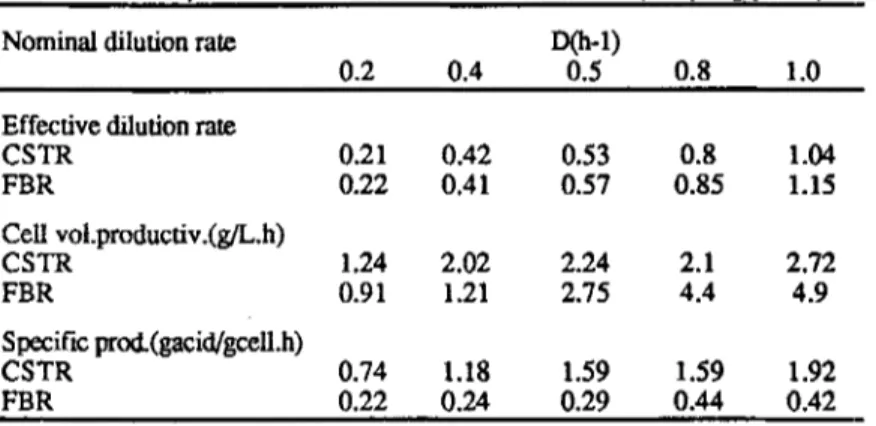STARTER CULTURE P R O D U C T I O N IN FLUIDIZED BED REACTOR WITH A F L O C C U L E N T STRAIN OF
L.plantarum
M.T.O.Barreto § E.P.Melo, M.J.T.Carrondo*
Lab. Engenharia Bioqufmica~ F C T / U N L
2825 Monte da Caparica, Portugal
+Escola Superior de Biotecnologia, Univ. Catdlica
R. Dr. Antdnio Bernardino Almeida, 4200 Porto, Portugal
SUMMARY
A lactic starter culture of a flocculent Lactobacillus plantarum was produced in a fluidized bed reactor with higher cell volumetric productivities than in a continuous stined tank reactor. The fluidized bed reactor w a s operated at optimised parameters obtained in batch reactor performed with and without pH control.
I N T R O D U C T I O N
Food and feed industries make an increasing demand for lactic acid starter cultures. Lactic starter cultures
can be used in the production of milk-derived products (cheese, yoghurt, butter, butter-milk) and fermentation of
cereals, vegetables and meats. They have important characteristics such as production of fiavours, bacteriocins
and antibiotics, and they are known to have nutritional and therapeutical benefits (Chassy, 1986; Day,1987).
LactobaciIIus plantarurn is a facultative heterofermentative lactobacillus, which means that it produces
mainly lactic acid from hexoses, but can produce lactic acid and acetic acid depending on the level of substrate
and oxygen in the medium (Condon, 1987; Sandine, 1987). Some of its industrial applications are production of
crackers, sauerkraut, pickles, green olives, cured ham, sausages, meats, silage starters.
Traditionally these starter cultures are produced by batch or continuous stirred tank reactors (CSTR)
followed by freezing or freeie-drying. To obtain a lactic starter culture more efficiently we are exploring the use
of a fluidizcd bed reactor (FBR) for biomass generation, using a flocculating strain. Fluidization keeps the
particles separated and individually surrounded by nutrients and, at the same time, reduces inhibitory final
products, thus mass transfer conditions and volumetric and biomass production rates can be several times higher
than in conventional submerged stirred fermentors. Also, at low Reynolds numbers (higher than, aproximately,
I) this reactor type has the highest energetic efficiency (transport efficiency/energy dissipated) in comparison
with C S T R or packed bed reactors (Cheetham, 1983).
M A T E R I A L AND METHODS
Culture used was
Lactobacillus plantarum
7, a flocculating strain supplied by Profs. V. BottazTi and S. Cocconcelli (Istituto di Microbiologia, Univ. Cattolica del Sacro Cuore, Piacenza, Italy). Culture was kept at 4~ in MRS medium (Man, 1960) and I~ansfered monthly.Experiments were performed with MRS medium which contained (per liter of deionized water): tryptone (Difco), 10g; beef extract (Difco), lg; yeast extract (Fould Springer), 5g;K2HPO4, 2g; sodium acetate, 5g; di- ammonium hydrogen citrate, 2g; MgSO4.7H20, 0.2g; MnSO4.H20, 0.05g; Tween 80, lml. Glucose concentration varied according to experiments (20,85g/i). For FBR, Tween 80 was omitted and tap water utilized throughout.
Dry weights of biomass were determined using 10ml samples of broth culture filtered through a membrane (0.2~tm) and dried for 72h at 105~ Turbidities of broth cultures were expressed as optical densities (O.D.) at 540nm. A calibration curve was constructed by plotting optical densities against dry weights.
Glucose, ethanol, lactic and acetic acids were determined by I-IPLC with a Shodex Sugar SH-1011 column (Macherey-Nagel), using 0.01N H2SO4 as the eluent, and a flow-rate of 1.0ml/min at 50~ a refraction index detector was used (ERC - 7511, Erma Inc., Japan).
Batch studies without pH control were carried out in 100ml flasks in a shaker bath.
Batch fermentations with pH control and chemostat studies (CSTR) were performed in a 2 L Setric fermentor (SGI, France).
The fluidized bed system (FBR) was a cylindrical column, 80cm in height and 4cm wide with an external settler allowing recirculation (fig.l), similar to the column utilised by Adisasmito to produce fungal starter cultures (Adisasmito, 1987). Temperature was controlled with a water jacket along the column and the pH value was maintained, aproximately, at the desired value by a pH control system, with a pH electrode placed at the top of the column.
r's
3 7~J s
c- -J
. . . - I
Fig. 1. Fluidized bed reactor 1 - Settler 2 - Feed vessel 3 - Overflow vessel 4 - pH electrode 5 - Base vessel 6 - Temperature control 7 - Sampling ports (1,2,3 and 4)
R E S U L T S AND DISCUSSION
L. plantarum
7 was used in batch experiments with and without pH control. Tests without pH control indicated 3 I~ as the ideal temperature. Under these conditions, the maximum cell concentration obtained was 4.2g/L, maximum cell and acid volumetric productivities were, respectively, 0.23g/L.h and 1. lglL.h.In batch tests with pH control, the pH was controlled with an ammonia solution at values between 4.5 to 6.5. Initial glucose concentration was 85g/L and temperature 31~ From the results the pH chosen was 5.5. Under these conditions maximum cell concentration, maximum cell and acid volumetric productivities were respectively, 11.9g/L, 0.56g/L.h, 2.2g/L.h.
In chemostat studies, temperature and pH were set at 31~ and 5.5, respectively, and the system was operated at different dilution rates (D). Studies were done with MRS medium and the initial glucose concentration was 70g/L. Results are shown in Fig.2 and Table 2. At high dilution rates wall growth could be observed, similar to reports refering to other lactic acid bacteria (Keen, 1972; Rogers, 1978), making the variation of cell concen=ation with diludon rate appear anomalous.
40.0 - 8.0 3.00 Fig.2. 30.0 e,,, o ~ 20.0 O ~ IO.O 0.0 0 0 0 6.0 4.0 2.0 O * 0 * O * 9 t o t r l O * o 0 , 0 0 O 0 a o a 0 0 r O 0 0 . 0 i i i i I i i i t i i i i I i i i i i i i i I 0.00 0.25 0.50 0.75 2.,50 ,-, d r 2.00 ~ 1 . 5 0 - - ~ 1.00 o > -0.50 0.00 1 . 0 0 1 . 2 5 DCn -1)
Cell ( o ) and lactic acid ( o ) concenwations, and cell volamelric productivity ( 9 ) in CSTR with L. plantarum 7.
The FBR was operated with a total system volume of 1740ml. The temperature was maintained at 31~ and the pH was controlled at 5.5. Tween 80 was omitted from MRS medium so that it would not interfere with the flocculation process. Medium was pumped into the fermenter at the desired dilution rate (D). The recirculation rate was 10 to 60 times higher than the feed rate. Samples were taken at three sampling ports (1,3 and 4 in Fig.l). Floes appeared soon after the column entered in continuous operation, and they had different sizes along the column, from very small at the top to an average of 10mm wide and 4mm height at the bottom.
Since these tests were carried out without biomass purge, apart from that occurring naturally in the effluent, we considered a steady state on the lactic acid production. Constant lactic acid concentrations were
obtained after 25 to 50 residence times. Results are shown in Fig.3. Effluent sUeam samples coincided with sampling port 4. B0.0
,•
60.0.8
i
4.o.o 20.0 I I I I I I J . 0 . 0 i i i i i i i t i i i i i i i i ~ r 0.00 0.25 0,50 0.75 1,00 , I .Z5V(h-1)
Fig.3. Cell concentration in FBR, sampling ports 1 ( * ), 3 ( ,, ) and 4 ( ~ ).
The efficiency of flocculation in the system can be assessed by a flocculation factor.
Flocculation factor = Cell concentration in the column samples
Cell concentration in the effluent stream
This flocculation factor was calculated for every dilution rate tested. Results are shown in Table 1. It should be noticed that after the initial jump in flocculating activity with an increase in D, the values of the flocculation factor became approximately constant. This might be interpreted as if at higher D a limitation to floc growth appears; thus there is an increase in free cells that are allowed to escape in the effluent.
Simultaneously, at higher D, there was higher addition of ammonia; this contributes to diminuish the average floc size as ammonia seems to interfere with floc stability.
Table 1 - Efficiency of flocculatlon in FBR. Flocculation factor
D (h "l) Samplin$ port 1 Samplin[ port 3
0.22 9.94 4A9
0.41 36.39 29.93
0.57 15.17 14.96
0.85 11.12 11.38
Cell volumetric productivities for FBR were calculated using the following mass balance: (:k dXreaetor ~ ' = D'x~ + dt (1) where, x - cell concentration, g.L -1 t - time, h D - dilution rate, h -1
The term D.xout is given by the free cells leaving the reactor, while the term dxreactor/dt is the contribution of the growth of floes during the time the system was kept at the same dilution rate.
The equation 1 does not account for the accumulation of biomass in the settler. This term was accounted for only at the end of each run, assuming constant rate of accumulation with time, representing approximately 0.3 g/L.h for the high dilution rates and lower values for the lower dilution rates.
The values for dae productivities thus calculated are presented in Table 2.
Table 2- Comparative results between CSTR and FBR (sampling port 1)
Nominal dilution rate D(h-1)
0.2 0.4 0.5 0.8 1.0
Effective dilution rate
CSTR 0.21 0.42 0.53 0.8 1.04 FBR 0.22 0.41 0.57 0.85 1.15 Cell vol.productiv.(g/L.h) CSTR 1.24 2.02 2.24 2.1 2.72 FBR 0.91 1.21 2.75 4.4 4.9 Specific prod.(gacid/gcell.h) CSTR 0.74 1.18 1.59 1.59 1.92 FBR 0.22 0.24 0.29 0.44 0.42
Comparative results between CSTR and FBR show that cell volumetric productivities, at low dilution rates are higher for CSTR, while at high dilution rates they are higher for FBR as expected.
At low D, in FBR, the floes are larger than at high D. Inside these floes, diffusional problems inhibit cell growth and lactic acid production, so less amonia is added to the system, as mentioned before, and less free ceils appear in the effluent stream. As the dilution rote increases, the smaller floes formed, work in a "virtuous cycle", as the diffusional limitations are then reduced allowing the cell volumetric productivity of the FBR to clearly overtake that of CSTR. These results indicate that continuous cell purge strategy should be applied at high dilution rates, when cell volumetric productivities are high and could then be improved.
The diffusional limitations inside the floes, mentioned before,could also explain the lower values of specific productivities in F-"BR, in comparison to CSTR.
As the aim of this work is the production of a starter culture, viability of the cells produced is a very important parameter. So, different types of methods for its determination are being tried, like CFU (colony
forming units) and a kinetic method based on the measurement of rate of change in pH at the start of a new fermentation.
The mechanism of flocculafion of this L. plantarum is not yet known. Scanning electronic microscopy
seems to indicate that there is extracellular material responsible for the adhesion of cells. As the mechanism of adhesion of other lactic bacilli is dependent on superficial carbohydrates, this hypothesis can be put forward (Bottazzi, 1987). Another important role in some mechanism of adhesion comes from the presence of cations in the medium, that could form bridges with the negative surface of bacteria and so help in the adhesion process (that is why tap water, which has calcium, was utilised). Experiments of flocculating activity with different cationic solutions are being carried out and, so far, the results are not very conclusive but seem to indicate no effects at ion concentration below 0.1 M. Ammonia has a definite effect in destroying or reducing the size of the floes, as indicated earlier, and might thus indicate protein bridge being destroyed in the floc.
These preliminary results in utilisation of a flocculent strain in a fluidized bed reactor will be completed with more experiments, at different recirculation rates and cell purge in order to verify the cell productivity values at real steady state; viability will also be measured by the above mentioned methods.
ACKNOWLEDGEMENTS
One of the authors,M.T.O.B.,thanks the Escola Superior de l~iotecnologia for the research leave. We thank Prof. R.Tengerdy (Fort Collins,Colorado) for the collaboration.We would also like to thank Profs.V.Bottazzi and S. CocconceUi (Istituto di Microbiologia,Univ.Cattolica del Sacro Cuore,Piacenza,Italy) for giving us the strain
L.plantarum 7 and the ongoing cooperation.The work has been supported by grant N ~ 3.3/P248 from Funda~ao
Lust Americana part o Desenvolvimente. The support of LP.E., S.A., is also acknowledged.
REFERENCES
Adisasmito, S., Mihaltz, P., Karim, M.N. and Tengerdy, R.P. (1987). Biotechnol. Techniques l, 175-180.
Bottazzi, V. and Sarra, P.G. (1987) I batteri lattici nelrecologia microbica del tratto digerente. In:
Aggiornamento di Microbiologia dei Batteri Lattici, V. Bottazzi, ed., pp. 221-238, Milano: Centre Sperimentale
del Latte.
Chassy, B. (1986) Lactobacilli in Food Fermentations. In: Biotechnology in Food Processing, LK. H_arlander
and T.P. Labuza, eds., pp. 197-207, New Jersey: Noyes Publications.
Cheetham, P.S.J. (1983). The application of immobilized enzymes and cells and biochemical reactors in
biotechnology. In: Principles of Biotechnology, A. Wiseman, ed., pp. 194-195, London: Surrey University
Press.
Condon, S. (1987). FEMS Microbiol. Rev. 46, 269-280.
Day, C.A. and Lisansky, 8.G. (1987). Agricultural alternatives. In: Environmental Biotechnology, C.F. Forster
and D.A. Wase, eds., pp. 234-294, Chicheste~. Ellis Horwood.
Keen, A.R. (1972). J. Dairy Res. 39, 151-159.
Man, J.C. de Rogosa, M. and Sharpe, MI:. (1960). J. Appl. Bact. 23, 130-135.
Rogers, P.L., Bramall, L. and McDonald, IJ. (1978). Can. J. Microbiol. 24, 372-380.


